Music Profile: Violinist, Teacher, Composer, and Arranger Mimi Rabson — Making a Life in Art
By Steve Elman
The life of a working musician is not a second-class life, and Mimi Rabson’s is Exhibit A: “I try to get past the limits of the definitions and get to the joy.”
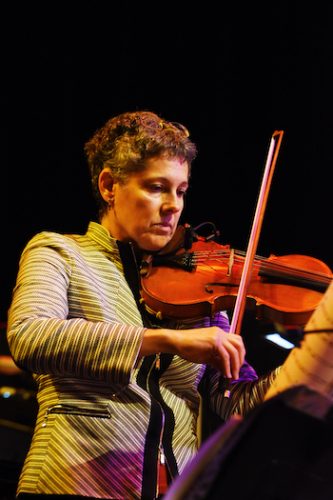
Mimi Rabson. Photo: Gaia Petrelli-Wilmer.
In almost every community, there are musicians who do not have glittering careers touring the world and playing the big venues. These are people who are making a day-to-day living with their art. I shorthand them as “working musicians,” even though that term applies to everyone from Beyoncé to the folks in the garage band playing for the door.
Reconciling the creative pulse with the need to put food on the table and support a family is a constant challenge for the “working musician.” Music schools and advanced institutions like Berklee and the New England Conservatory offer them invaluable financial grounding and sometimes full-time income. But there is a cruel reality: not all artists have the resources, ingenuity, and luck to satisfy both soul and body with style. The ones who do, those who rise to the challenges gracefully — these people become a kind of artistic backbone for a community.
They may never be household names, even in their hometowns. But we must not misjudge them: the life of a working musician is not a second-class life.
Exhibit A: Mimi Rabson, first-class instrumentalist specializing in the five-string violin, full professor at Berklee, mentor to young and promising string players, accomplished performer of jazz and jazz-related musics, author of practical guides to arrangement and orchestration, composer of chamber music and improvisational pieces, original member of the Klezmer Conservatory Band, leader of cross-genre ensembles RESQ (string quartet), Strings Theory Trio (two violins and cello), co-leader of Triarky (power trio), and a member of the Jazz Composers Alliance since 2015, one of Boston’s most venerable institutions of great music.
Over the past month, I spoke with Rabson at length about her life and her work, and I discovered that she is also a deep thinker. I came away from those conversations with an enriched understanding of what it takes to make a life in art.
Mimi Rabson is not “typical,” whatever that is. In fact, there is no “typical” working musician, because each person faced with the challenges of life and art deals with those challenges in a different way.
She is not conventional, whatever that is, because there is no convenient pigeonhole into which she can easily be wedged.
She is not esoteric, because she can write and play (convincingly!) any kind of music from straight classical to heavy metal, and she obviously enjoys playing whatever she chooses to play. “Lots of people try to define music by genre,” she says. “I try to be genre-fluid, to get past the limits of the definitions and get to the joy.”
To tell you about who she is and what she does, I have to tread lightly. When speaking about her own reluctance to talk in any detail about her work, she said, “I’ve always felt words are insufficient. Using words to talk about music is such a peripheral, scratch-the-surface-of-the-meaning way of doing things.” Well, fools rush in…
We have to start somewhere in her varied career, so let’s begin with the most recent commercial release featuring two of her large-scale compositions — the Jazz Composers Alliance Orchestra’s Live at BPC (JCA, 2020), recorded at a 2018 concert at Berklee.
The JCA was founded in 1985 as a nonprofit by composer Darrell Katz, who continues as its first-among-equals. The 20+ players in the band today are among the area’s best, including trumpeter Mike Peipman, saxophonist Phil Scarff, trombonists David Harris and Bob Pilkington (both of whom are also part of the current composers’ roster), and a stellar rhythm section — pianist Maxim Lubarsky, bassist Jesse Williams, drummer Tony “Thunder” Smith, and percussionist Gilbert Mansour. Early on, Katz had the vision to add vocals, violin, and vibes to the arsenal of colors available to composers, and in this recording, you’ll hear Rebecca Shrimpton, Helen Sherrah-Davies, and Vessela Stoyanova fill those roles delightfully, as they have for a number of years.
With this release, Rabson becomes a member of an exclusive and prestigious club, since the list of former JCA composers includes Laura Andel, Bill Lowe, Ken Schaphorst, and Warren Senders, and the group has commissioned works by Muhal Richard Abrams, Marty Ehrlich, Julius Hemphill, Wayne Horvitz, and Sam Rivers.
Her works were not “new music” at the time of the recording. The JCA Orchestra had played them in previous concerts, and she thinks the performances here are better for it:
“The premiere of anything often needs work. It’s very hard to pull together a [new] piece in a short period of time, with teaching obligations and such. So, all of us [the JCA composers] have repeated our compositions in various performances. Which honestly, I think, is a great idea.”
In her group Strings Theory Trio, Rabson works with JCA violinist Sherrah-Davies (herself a contributor of works for the orchestra), so it was logical for her to call upon the other member of the trio, cellist Junko Fujiwara, to join the bigger ensemble. Rabson features both of them on the leadoff, “Romanople.”
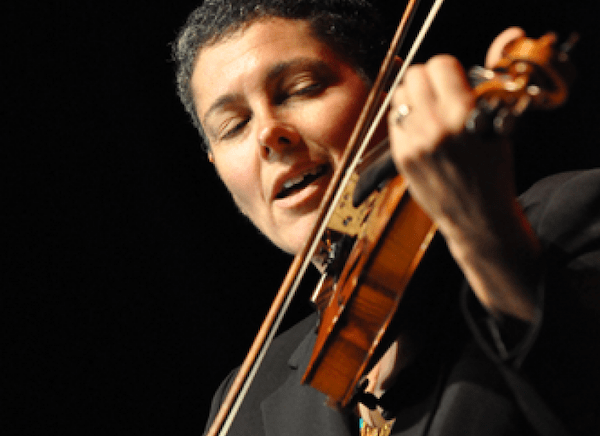
Mimi Rabson. Photo: Berklee College of Music.
“Junko does everything beautifully, but the thing she is closest to is free improvisation, and [at that] she is spectacular. [For] the solo she took on ‘Romanople,’ nothing was written down — not even a chord change. She just played music.”
The piece has a program that developed gradually.
“I was reading Edward Gibbon’s The History of the Decline and Fall of the Roman Empire, and I was deep into Volume II, where the empire has two capitals [Rome and Constantinople]. [I thought,] What would it be like as a human being to live like that? It’s one country — many, many countries, really — and there are two capitals, so culturally different from each other.
“Let’s say I’m a musician. And I’m living in the Roman Empire, and I travel because I want to make a living and I can’t do it in my little town. So, when I’m in Rome, what kind of music would I be playing? When I’m in Constantinople, what kind of music would I be playing?”
Rabson fantasized a simple melody, and then took the tune through cultural transformations, beginning with an Eastern-European harmonization and ultimately moving it to Rome, “where it meets a brass band,” and is caught up in a cataclysmic battle of free improv before it “dances off to its next incarnation.”
That little tune’s journey leads us back to 1980, the real beginning of her professional career, when she became a featured violinist in Hankus Netsky’s Klezmer Conservatory Band. The group found international success, and that allowed Rabson herself to do a lot of traveling from culture to culture.
“I didn’t join [the group] as a political comment, or a religious comment. I joined it because I thought, ‘I can be a violin player and play with a drummer. That sounds like fun to me.’ It turned into this huge political statement. It was pretty overwhelming.
“Klezmer music is very interested in discovering and incorporating the music that it is near. Klezmer musicians traversed a huge region — if you’re playing a wedding in Odessa, you better know some Odessa tunes. If you’re playing in Constantinople, you better know some Constantinople tunes. In the klezmer literature, there’s a whole repertoire of Arab tanzes. There’s a whole repertoire of bulgars, from Bulgaria. There are a whole bunch of polkas.
“One of my favorite [concerts] was in Krakow [Poland] at a festival which has now become a big festival [the International Folklore Festival], in 1980-whatever-it-was, a year and a half before the [Berlin] Wall came down. It was the first time Jewish music had been heard in Poland in a generation. The electricity at that performance was astounding. The Poles who were at that concert said, “This is such an incredible part of who we are as [a] people, and we haven’t heard this music for so long.’ We got four encores at that concert — four ovations. I will never forget that reception.
“For me, the most fun playing is to play for people who want to dance. People danced at every Klezmer Conservatory Band concert.”
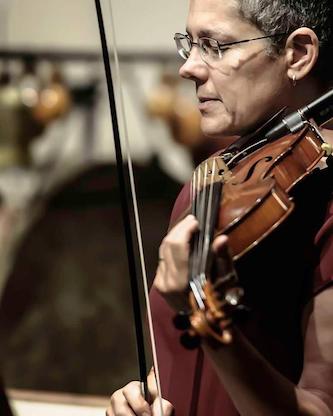
Mimi Rabson. Photo; Rob Miller, courtesy of giantevilclown.com.
Her 17 years with the Klezmer Conservatory Band raised her profile within the music community in Boston. She played publicly with her own groups, pursued composition and recording projects, and joined the faculty at Berklee, where she put into practice a strong philosophy of teaching built on ear work.
As a central element of her teaching today, she asks students to imitate great recordings by great stylists, specifically forbidding them from trying to capture what they hear with traditional notation:
“The only way to become a real musician is to be hearing what you’re doing, not just seeing it.
“I make all my students learn other people’s solos by ear. Because all of [the nuances] — Are you in front of the beat or behind the beat? How wide is your vibrato? How fast is this ornament? Where are the accents and ghost notes? — all of those little things — you hear [them] when you’re listening to somebody, but they disappear when [the notes] go on to a page.
“Don’t get me wrong. Musicians have to be able to read music — that is critical. But when you are interested in something that moves you, you [have to] figure out all the parts of what moves you, and one of the things that might be moving you is where things sit on the beat, [or] the way people use intonation. [If] you write it down, you lose all the cool, interesting, important pieces that make [a player’s style] unique.
“The trick as a teacher is to find that spark that is motivating [a student], and then develop that spark. If you can find that spark, then getting to those other places is a joy, and a pleasure — and [it fulfills] a desire that they have.”
But the “composer” and “teacher” descriptions still don’t give you a complete picture of Rabson’s life as an artist, since I haven’t yet talked about her impeccable, exciting work as a player. Even though her list of recordings is not long, it is remarkably varied. (See More below for a comprehensive summary.)
A listener who wants to hear her rock out should go to bandcamp.com and hear the virtual album Shakin (Meemzmusic / Contrabone, 2018) by Triarky, the “power trio” she co-leads with her husband David Harris, who plays electric tuba (!!) here. Drummer Phil Neighbors complements them both with all-out (but sensitive) support.
A listener who wants to hear her performing roots repertoire should hear her sister Ann Rabson’s CD, In a Family Way (Emit Doog, 2005). She and Harris are the featured soloists in the backup band, and both contribute sharp solos that are fully committed musically but absolutely within the conventions of good-time blues, which is Ann Rabson’s wheelhouse. (By the way, Harris will impress you on this date with his command of hot trombone technique.)
A listener who wants to hear her in jazz-related material should hear everything on her CD Music (Meemzmusic, 2001), which covers a lot of satisfying ground. One fine example: “Sometimes,” which is almost countryish at first, and then unfolds with a modern R&B / gospel sensibility. Her solo here is a gem, warmly played, using the dark lower register of her five-stringed instrument very effectively, and her outchorus capitalizes on the “vocal” implications of the tune.
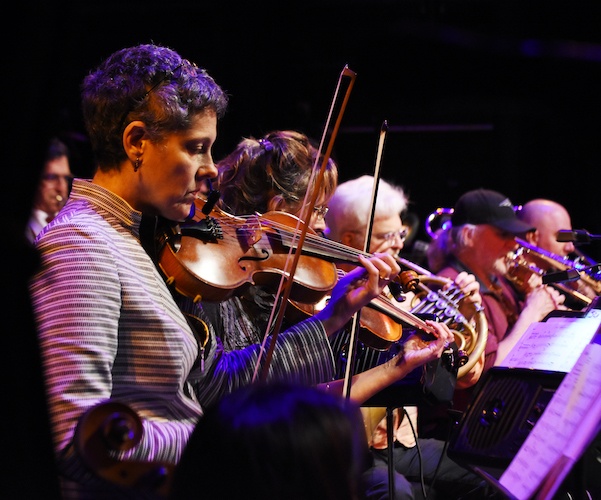
Mimi Rabson with the JCA Orchestra. Left to right: Rabson, Helen Sherrah-Davies, Jim Mosher, Bob Pilkington, Jason Camelio. The trumpeter at the rear is Gary Bohan. Photo: Gaia Petrelli-Wilmer.
And a listener who wants to hear her play “serious music” will find plenty to chew on in Strings Theory (Meemzmusic, 2012) the first CD with her chamber-music group. It contains her second string quartet and her first string trio, each beautifully crafted, in a vocabulary that the average classical listener will surely hear as modern but melodic.
The string trio in this release is particularly innovative, because her score provides unconventional directions:
“Very little of what we’re actually playing is on the page — very few notes, very few rhythms. At least 90 to 95 percent is not notated. Most of what we’re playing is improvisational.
“It was kind of an experiment to see how little or how much I need to include [as a composer] to direct [the players] into this [story I wanted to tell].
“I have these players to work with — what can I get them to do?”
Despite the nature of the score, the performance of the trio is remarkably well-focused. The second movement, for example, emphasizes contrast between long, quiet sustained notes and skittering effects, but the development of these ideas sounds like a single intelligence is guiding its progress.
This leads us back to Rabson the composer, and to the big finish of the new JCA CD, her composition “Super Eyes – Private Heroes,” a flag-waving, bring-’em-to-their feet stomper that contributes (in her words) to “one of my favorite musical genres,” the jazzy scores for films and TV shows of the ’50s and ’60s. The heart of the piece is given to solos by Melanie Howell-Brooks, playing baritone sax; Helen Sherrah-Davies, playing five-string violin; and David Harris, who contributes a romping, gutbuckety trombone display that almost steals the show. Rabson almost quotes the big ending to Lalo Schifrin’s theme from Mission: Impossible ([TV], 1966). She makes more oblique references to John Barry, Jerry Goldsmith, Quincy Jones, Nelson Riddle, and Henry Mancini (Mansour’s bongos hint at the score for Touch of Evil [1958]). She also points to the retro ideas of a contemporary woman composer a student brought to her attention — Yoko Kanno, whose “Tank!” pays homage to the same genre (It was written for the anime series Cowboy Bebop [TV, 1998]).
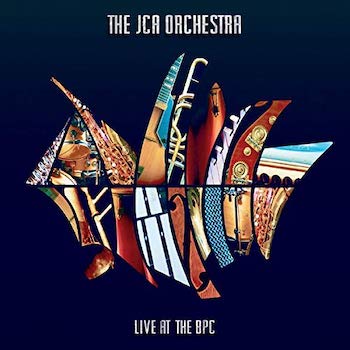 Her two works, and the outstanding compositions that make up the rest of the CD, make it one of one of the best recordings ever by the Jazz Composers Alliance. There is hardly any way to fault it, except for the fact that the music is so interesting that a listener should take a break between the works to let one settle in before you hear another. (See More below for some other observations about it.)
Her two works, and the outstanding compositions that make up the rest of the CD, make it one of one of the best recordings ever by the Jazz Composers Alliance. There is hardly any way to fault it, except for the fact that the music is so interesting that a listener should take a break between the works to let one settle in before you hear another. (See More below for some other observations about it.)
Where does Mimi Rabson go from here? Here’s a preview and a hint of her creative process:
“Right now, I’m working on a double violin concerto for me and Helen [Sherrah-Davies], which I hope we will play with the JCA. It started early last summer because Dave and I and our son Sam, who is also a musician, were having some kind of conversation about harmony — could this chord follow this chord? And I started working on the piece from there. After a while, I was thinking, ‘Oh, this is crap! It’s never gonna be any good.’ And a couple of days later, ‘Oh, that’s running through my head again. Maybe I better look at it more.’ And then, ‘Oh, it’s terrible! What was I thinking?’ A couple of days later, there it is back again. And just a couple of days ago, I had a little breakthrough about it, how to make it make sense. And now it’s running through my head, running rampant.
“Also, I’ve been working on my newest book, an arpeggio and étude workbook for violinists learning to play over changes.
“Most of the music that I listen to, that I enjoy, has a larger connection than just sitting and listening to it. Whether it’s got a good beat, or [a sense of] ceremony, or it’s part of a larger human event, those are the puzzles that capture me. I hear music, and it interests me. I hear it enough that I want to hear more, think about it more. It chooses me. I don’t go after it.
“I didn’t get into this business because I wanted to be famous. I love playing good music with good people. There’s no better thing to be doing. I have gotten to do that, and I’m very grateful for it.”
As a postscript, here’s one word more from me, for Rabson and for all of her fellow “working musicians”: Respect.
More:
Mimi Rabson: a selected cycloforiagraphy
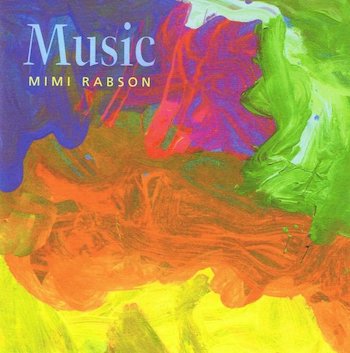 With the onset of digital albums like the Rabson-Harris Triarky, and tracks and live performances that only appear on websites and streaming sites, more and more releases aren’t on vinyl discs or CDs at all. We’re going to need a new term to replace “discography,” so I’m offering this one (accent on the fifth syllable, please) composed of Greek kykloforias (“release,” in the sense of a recording on the commercial market) and the usual -graphy suffix.
With the onset of digital albums like the Rabson-Harris Triarky, and tracks and live performances that only appear on websites and streaming sites, more and more releases aren’t on vinyl discs or CDs at all. We’re going to need a new term to replace “discography,” so I’m offering this one (accent on the fifth syllable, please) composed of Greek kykloforias (“release,” in the sense of a recording on the commercial market) and the usual -graphy suffix.
Klezmer Conservatory Band (led by Hankus Netsky, reeds, p): Oy Chanukah! (rec. 1985; Rounder, 1987) Rabson (violin) performs here as part of a 14-person edition of KCB that includes Judy Bressler, vo; Frank London and Ingrid Monson, brass; Evan Harlan, p, acc; Jim Guttman, b; and Grant Smith, dm. Hearable on Spotify.
Mimi and mandolinist David Brody are featured on her composition “Klezzified.”
RESQ: The Really Eclectic String Quartet (rec. 1990; Northeastern Popular Arts, 1992). Rabson & Matt Glaser, v; Melissa Howe or Patrick Jordan, vla; Jim Guttman, b
The repertoire pays off the title – here are five of Rabson’s own pieces, plus arrangements of music by Ellington and Monk, music from Romania and Serbia, and Richard Berry’s “Louie, Louie.”
RESQ: To the RESQ (Meemzmusic, 1998) Rabson & Eric Bindman, v; Melissa Howe, vla; Jim Guttman, b
The second outing is more focused on her tunes than the first was, but it includes one by Guttman (whose bass is crucial to RESQ’s sound), the ancient trad standard “Tin Roof Blues,” and a James Brown hit.
Mimi Rabson: Music (Meemzmusic, 2001) Rabson, v; Rick McLaughlin e-b (b on “Marking Time”), Harvey Wirht, dm; and, on several tracks, David Harris, tb, org; Dennis Montgomery III, org; and Ricardo Monzon, per. Liner notes by Warren Senders.
Even though this CD is made up of her music exclusively (including her reworking of the Duke Ellington-Juan Tizol “Caravan,” wittily renamed “Craven”), this is far from a one-dimensional recital. There’s fuzz violin à la Hendrix, a polytonal Ornettish tune (“The Next Vehicle”), a little funk, a little reggae, some NOLA strut, and even a glance to Korea and Japan.
Ann Rabson: In a Family Way (Emit Doog, 2005). Ann Rabson, vo, p; Mimi Rabson, v; David Harris, tb, org; Liz Rabson Schnore, g; Steve Rabson, p; Kenji Rabson, b. Hearable on Spotify.
Here’s a perspective that’s decidedly different from her other recordings, but the music is just as good. Listen to her shaping of Willie Dixon’s “Three Hundred Pounds of Joy.” Ann Rabson’s vocal is at the center, as it should be, but Mimi Rabson (violin) and David Harris (trombone) contribute little arranged passages behind her and each of them takes a snappy break, followed by a break in which they solo together. It’s just long enough, and much better than it has to be.
“The Jam,” on David Harris and Nu Quartet: Slide of Hand (Contrabone, 2007) – Harris, tb; Rabson, v; Rick Peckham, g; Bruno Råberg, b; Richie Barshay, dm. Hearable on Spotify.
“The Jam,” a feature for Rabson from her husband’s CD, provides a look at yet another facet of her talent. This is an Indo-klezmer composition by Harris that opens with Rabson solo and evolves into a free-form duet for trombone and violin over rhythm, followed by a fiery Peckham guitar solo. She shows here how easily she fits into a context that is very different from the ones under her own name.
Ken Field: Sensorium: Music for Dance and Film (Innova, 2012). Hearable on Spotify.
Rabson performs as part of an ensemble here, playing compositions by Field, who is known for his work with Birdsongs of the Mesozoic and Revolutionary Snake Ensemble. She is featured on the title piece, which begins with some minimalist ideas and then unfolds elegantly.
Mimi Rabson & Strings Theory Trio: Strings Theory (Meemzmusic, 2012)
This release includes two classically oriented compositions by Rabson.
Her String Trio No. 1 (with Rabson, 5-string v; Helen Sherrah-Davies, 5-string v; Junko Fujiwara, cel) is discussed above.
Her String Quartet No. 2 has a different lineup, with Rabson, 4-string v; Francine Trester, 4-string v; Melissa Howe, vla; and Shannon Snapp, cel
Rabson cites inspirations for this piece from novelty hip-hop (“Peanut Butter Jelly Time” by Buckwheat Boyz) to heavy metal to “the cliché used in old TV shows to suggest a flashback,” although the music turns these elements to higher purposes. Perhaps the most personal movement is the second (Adagio). She says it’s a “description of the creative process … dissonance … starts and stops … arduous forward motion … a cathartic peak, [and] resolution with a bit of lingering doubt.”
Strings Theory Trio: “Metalyptica” (live recording at Berklee, 2015; released on YouTube). Rabson, 5-string v; Antoine Beux, 4-string v; Aodán Collins, cel
This is sort of a pickup version of Strings Theory Trio, with other Berklee colleagues energetically filling the second violin and cello chairs. In this short piece, Rabson sets up an ostinato inspired by heavy metal, carried mostly by cellist Collins, and then provides a written section followed by improvised solos for each player over it. The trio works up a great head of steam here, and Beux has a smoking violin solo that gets shouts of appreciation from the audience.
Leap of Faith Orchestra (led by PEK [Dave Peck], composer, reeds): Possible Universes (Evil Clown, 2017). Rabson (violin) performs here as part of a 24-person ensemble that includes PEK, Glynis Lomen, cel; Yuri Zbitnov, dm, per; David Harris, tb; Steve Provizer, tp, baritone horn; Dan O’Brien, reeds; and Syd Smart, dm. Hearable on Spotify.
Here is Rabson in an all-out setting that is not for the faint of heart. PEK has been making uncompromising music in the area since at least the ’90s, chiefly with Lomen and Zbitnov as collaborators and often with Smart. He describes his Leap of Faith Orchestra as “a pure improvisation ensemble collaboration,” and considers Rabson one of his star guest artists. She says, “He has written long complicated scores that are divided by time rather than meter. The scores are a thing of beauty. He, like Ellington, writes for each player.” On this recording, Rabson and the other string players have a feature spot of about two minutes following the huge ensemble crescendo at about 30 minutes into the work. She has participated in more than 20 recordings with PEK’s various ensembles, which are described in vast detail on his website, giantevilclown.com
Triarky (Rabson, elec 5-string v; David Harris, elec tu; Phil Neighbors, dm): Shakin (Meemzmusic / Contrabone [digital album] via bandcamp.com, 2018)
A sample track (“Shakin”) is hearable at no cost on the bandcamp site and the entire album is available on a pay-as-you-can basis.
You have to hear it to believe it. The free track leads with Hendrix-like violin and will give you a good sense of what the band can do. But I recommend buying and savoring the whole thing, so you can hear the track named after the band itself: “Triarky” begins with a N’awlins parade feel, but there are some surprising dynamic shifts. Both Rabson and Harris have very good solos, and Neighbors shows his stuff over a vamp from the others. To cap it, Rabson adds Whammy II effects to her instrument that give her the impact of a full string ensemble.
JCA Orchestra: Live at BPC (rec. 2018; JCA, 2020). Hearable on Spotify.
In addition to the compositions by Rabson described above, this new release includes one by trombonist Bob Pilkington (“The Sixth Snake,” including a fine solo by the composer), one by JCA founder Darrell Katz (a touching revival of his “A Wallflower in the Amazon,” in memory of his wife, poet Paula Tartarunis), and two by David Harris. Read on.

David Harris. Photo: JCA Orchestra.
Here’s a too-short nod to Rabson’s husband David Harris, fellow JCA composer, superb trombonist and tubist, and associate professor at Berklee.
His sound on trombone is distinctive and versatile — not the creamy J. J. Johnson paradigm, nor the raucous Gary Valente rasp, but somewhere in between, and he can move almost to either end of the sound spectrum at will. As a tubist, he could fill the late Howard Johnson’s shoes if he chose to — and as an electric tubist, he is blazing (pun intended) a new trail.
As a composer, he has two great influences — modal music (from world traditions like klezmer, Ethiopian music, and Indian classical), and the open-structure techniques of Barry Guy, Henry Threadgill, and especially Butch Morris.
Harris has recorded extensively, but he has one of the great disambiguation problems — a lot of other people in the performing arts have similar names. Spotify mixes up his work with that of singer-pianist David Harris; one David L. Harris, from Baton Rouge, is also a trombonist, but he sings as well; tenor saxophonist Dave Harris played with Raymond Scott; another Dave Harris does standup comedy; David Ryan Harris is a singer-songwriter; and there are many more.
To find the Harris I’m talking about here, you have to look for most of his work under the names of others: Jazz Composers Alliance (JCA) Orchestra (where he’s been a composer and soloist for more than two decades), Les Misérables Brass Band, Revolutionary Snake Ensemble (another terrific brass band), Debo Band (Ethiopian-jazz fusion), the Klezmer Conservatory Band, Frank London’s Shirim Klezmer Orchestra, Naftule’s Dream, and most recently, Triarky.
JCA Orchestra, Live at the BPC, discussed above, also includes two Harris compositions, “The Latest” and “Orange, Yellow, Blue.”
“The Latest” opens freeishly, and then sets up a very attractive ostinato-with-a-bridge, led by voice and violin. A second theme, after Melanie Howell-Brooks’s bass clarinet solo, is modal, with effective open orchestration. Trumpeter Norm Zocher solos on this, and then the original groove returns.
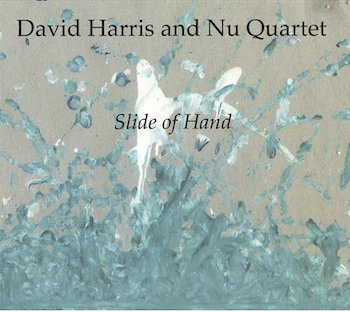 “Orange, Yellow, Blue” is the real showpiece here, utilizing Butch Morris’s conduction techniques that allow Harris freedom to shape the piece on the fly, with enormous impact. There’s a freeish open, followed by a passage for horns and vibes (the principal theme, rubato). Then we hear the theme in tempo, by trumpet and violin, over a modal repeating groove that recalls George Russell’s late work to this listener. This leads into a second theme, an Indo-klez line. After a break, guitar, piano and bass set up an irresistible foundation for a trumpet solo by Dan Rosenthal. There’s another break for the horns without rhythm, and then the groove returns — over which variants of both themes are combined, one in tempo, one out of tempo. The tempo doubles powerfully for solos by trombonist Jason Camelio, drum breaks by Tony “Thunder” Smith, and conga breaks by Gilbert Mansour. The first theme returns, elaborated and finally stated by everyone in unison. A sudden stop and a freeish ensemble conclusion wrap everything up. Almost as impressive as the impact of the piece is the fact that Harris is doing a lot of spontaneous shaping and creating from the podium as it develops.
“Orange, Yellow, Blue” is the real showpiece here, utilizing Butch Morris’s conduction techniques that allow Harris freedom to shape the piece on the fly, with enormous impact. There’s a freeish open, followed by a passage for horns and vibes (the principal theme, rubato). Then we hear the theme in tempo, by trumpet and violin, over a modal repeating groove that recalls George Russell’s late work to this listener. This leads into a second theme, an Indo-klez line. After a break, guitar, piano and bass set up an irresistible foundation for a trumpet solo by Dan Rosenthal. There’s another break for the horns without rhythm, and then the groove returns — over which variants of both themes are combined, one in tempo, one out of tempo. The tempo doubles powerfully for solos by trombonist Jason Camelio, drum breaks by Tony “Thunder” Smith, and conga breaks by Gilbert Mansour. The first theme returns, elaborated and finally stated by everyone in unison. A sudden stop and a freeish ensemble conclusion wrap everything up. Almost as impressive as the impact of the piece is the fact that Harris is doing a lot of spontaneous shaping and creating from the podium as it develops.
Other JCA releases on which his works appear include two he co-produced: Celebration of the Spirit (CIMP, 2003), which includes his composition “Th-Outward,” and In, Thru, and Out (Cadence, 2003), which includes the title piece and “Testify.”
Harris’s only effort as a leader to date is David Harris and Nu Quartet: Slide of Hand (Contrabone, 2007). It is hearable on Spotify, but you must search for “David Harris Nu Quartet” to avoid confusion. It is also hearable on YouTube, Napster, and (with a subscription) Apple Music.
This is a wide-ranging set of inventive Harris originals, where guitarist Rick Peckham is given almost as bright a spotlight as the leader. The music is smart, approachable contemporary jazz, with spice drawn from rock, Indian music, klezmer, funk, and freeish improv. These diverse elements are melded with confidence, and the CD speaks with a single voice. Harris plays trombone throughout, with some electronic effects to add depth, and he adds a little mouth percussion on “Unseen.” The side players are all outstanding — Peckham, elec g; Richie Barshay, dm: Bruno Råberg, b; with Mimi Rabson, v on “The Jam.”
Steve Elman’s more than four decades in New England public radio have included ten years as a jazz host in the 1970s, five years as a classical host on WBUR in the 1980s, a short stint as senior producer of an arts magazine, 13 years as assistant general manager of WBUR, and fill-in classical host on 99.5 WCRB.

Nice writing about a wonderful & important musician! Wanted to add that my composition “Sensorium”, referenced above in Rabson’s discography, was written as the sound element for the abstract animated film of the same name by my late wife, filmmaker Karen Aqua (http://karenaqua.com). We were so lucky to have Mimi on board for this!
Mimi Rabson and Dave Harris are visionary creative artists AND dedicated professionals. It’s a pleasure to read such a comprehensive and sympathetic piece on two of New England’s most valuable musical resources.
It is so great to read this feature on Mimi and Dave. They have both been friends and colleagues of mine since the 80’s when I first started playing with them during my studies at New England Conservatory. Amazing creative musicians AND people!!